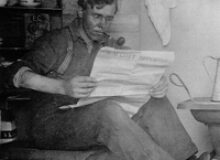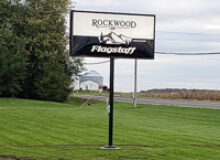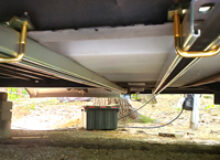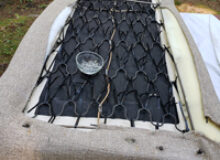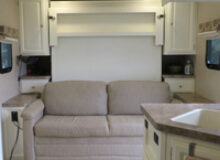Thomas Elton Tape Transcription – Tape 1 Side 1
Childhood through Great Depression (approx 1896 to 1932)
Preface: My grandfather and grandmother homesteaded in North Dakota in the early 1900’s. I adored my grandma and grandpa. Grandpa was born in 1888 and grandma in 1893. Unfortunately grandma died when I was 5 years old, but grandpa lived to be 97.
By 1980 he was in a wheel chair, the result of arthritis, broken hips, and a life of hard work. His vision was pretty much gone due to macular degeneration, and his hearing was very bad even with a hearing aid. It was a source of immense frustration to me that he couldn’t hear my higher pitched voice at all. We couldn’t have a conversation.
Since we couldn’t talk, I thought a tape recorder not only would give me their story, but give him a project for the long North Dakota winters. He was still living at home by himself.
Some points on my transcription of the tapes: If I simply could not make out a word or phrase with any level of confidence it is followed by (?? 22:16:47) which is the time on the tape. If other family members listen and can make out what he said, please email me and I will correct the transcription.
This was unscripted, just grandpa sitting at his kitchen table reminiscing, so I have also removed hesitation words to make for easier reading.
I have provided some additional information in brackets [ notes ] to explain words he uses for those who may be unfamiliar.
My grandpa died in October 1985 at the age of 97. This project is my way of saying I still think of you often and love you as much as I did then.
Thomas Oscar Elton Born August 22, 1888 Died October 14, 1985
Mamie Ethel Madsen Born February 4, 1893 Died July 25, 1960
Married August 2, 1916
Hi folks. The beginning of a new year. I wish you all a very happy, prosperous, and peaceful new year.
I have just {he pronounced it yust} observed my 92nd Christmas and reflecting back over the years, I find I enjoy (?? 00:34:44) about Christmas time, which is a really a great holiday in those days. Christmas lasted about 2 weeks according to Norwegian custom and Christmas Eve {he said New Year’s Eve accidentally} all the churches peeled out their chimes to ring in the Christmas season and all the work stopped. And so it was a very happy time for all the children. We all were very happy about Christmas, waiting for Santa Claus for gifts.
On Christmas Eve my mother prepared a big feast which was the chief feast at Christmas and with lutefisk and lefse and all the trimmings and we had a great time. There were no gifts to be dealt out on Christmas Eve. All the gifts for the children they were provided by Santa Claus and found in our stockings on Christmas morning.
[ Lutefisk (Norwegian) or Lutfisk (Swedish) (pronounced [l??tfesk] in Northern Norway, [l??t?f?sk] in Central and Southern Norway, [l??tf?sk] in Sweden and the Swedish-speaking areas in Finland (Finnish: lipeäkala)) is a traditional dish of the Nordic countries and parts of the Midwest United States. It is made from aged stockfish (air-dried whitefish) or dried/salted whitefish (klippfisk) and lye (lut). It is gelatinous in texture, and has an extremely strong, pungent odor. Its name literally means “lye fish.” Source: http://en.wikipedia.org/wiki/Lutefisk ]
[ Lefse is a traditional soft, Norwegian flatbread. Lefse is made out of potato, milk or cream (or sometimes lard) and flour, and cooked on a griddle. Source: http://en.wikipedia.org/wiki/Lefse ]
Well, there’s been a great deal of changes made, a lot of new inventions and when we were children why there was no telephone, or no radio, no television, and no automobiles. So I remember one time I went to Fargo with my father and we drove a horse and buggy. And we went in a store and I saw somebody talking, looked like he was talking to a horn fastened on the wall. And when we got home I told my mother about it, I saw a man talking to a horn in the wall, wondering what in the world he was up to. So she said {chuckling} it must have been a telephone because they had heard about the telephone, but there was no telephones around home, not even in the towns.
It was several years before we got the telephone and then they built the line around in the neighborhood and there was 26 families on the line and when one phone rang all the phones in the circuit rang and we’d see neighbors coming on right and left and it wasn’t safe to give any secret on the telephone in those days because everybody listened or they had the chance to if they wanted to.
So there was nothing but hard work on the farm, everything was done by hand, all the hay, and straw, and manure and everything was done by hand, and earth moving was also done with a shovel, and grain was handled with a shovel. And it was really a lot of hard work. We had to help all we could as soon as we got big enough to do anything.
We began school when we were 8 years old. There wasn’t any schoolhouse built until that time and we started school when we were 8 years old. The first year we went to school, why there was 28 children in that little school and they learned all children. There a lot of big boys and girls going there. We had a teacher, one of our neighbor farmers was teaching, he had an education before he got there. He was a very good teacher, but he was very strong on discipline and if you talked, we couldn’t speak a word of English and if we were caught speaking Norwegian on the school ground and the girls heard it, why they’d chase in and tell the teacher on us and we were penalized. But it didn’t take so very long before we could talk a little bit so we got along.
I missed a lot of school, I had to stay home to help dad, and Albert my twin brother he was a little bit slower to learn and so it was up to me to lose out. When we were 15 years old we stayed after school to read for the minister. So we lost out one year and the next year I went to school and then that was the last year I went because we were 16 then and we were not required by law to go to school anymore. I landed in the 7th grade and that’s all the schooling I got.
When I was 17 years old I went to hire out to thresh, to thresh, and in those days the grain was all threshed with a threshing machine with a steam engine for power. I wanted to learn to run the steam engine because that was really my hobby. I’d run, before I was able to do anything to help, when the threshers came around I was sitting by the engine all day, wondering, and trying to figure out what made it run. So in the fall after threshing, there was short course in agriculture offered at the agriculture college in Fargo and that included blacksmithing and steam engineering and I wanted to learn steam engineering so I went there and enrolled in that school and went there for 4 months.
And then after that I spent all my falls in threshing operating a steam engine which I enjoyed very much. After a couple three years I acquired a machine on my own so I was threshing myself.


Then in 1912 a portion of the reservation opened up, Berthold reservation opened up, and both I and Albert would like to acquire some land and we decided we was going to try.
[ The Fort Berthold Indian Reservation is a U.S. Indian reservation in western North Dakota that is home for the federally recognized Mandan, Hidatsa, and Arikara Nation, also known as the Three Affiliated Tribes. Created in 1870, the reservation is a small part of the lands originally reserved to the tribes by the Fort Laramie Treaty of 1851, which allocated nearly 12 million acres (49,000 km²) in North Dakota, South Dakota, Montana and Wyoming. Source: http://en.wikipedia.org/wiki/Fort_Berthold_Indian_Reservation ]
They set up stations for registration in different towns throughout the state and advertised the date for registering for that land. I and Albert, we went to the nearest town, I think it was Valley City, and registered, Then after the registration why they assembled all the registrations and took them to the land office and then they started drawing. The first number drawed had the first chance on land and so it went down and they drew many, many more names than there was land for. But Albert, he got the number and it was a high number and it was higher than there was any land and I didn’t get any number and later in the fall he got a notice that he should go file. So he went and he filed and there was a lot who had dropped out and backed out and had given it up and so he got a quarter and then later in the fall I went out there with him and helped him build a house. And, I was, I kind of liked to contribute but there was just all prairie, not a tree in site, nothing but the Indian trails, and lots of Indians roaming around.
And after all we got the house built I went back home again then and I was wondering if it wasn’t possible there might be something left that I could get and Albert wrote and said he didn’t think there was anything left, but I could come out and see. So it was spring then, before spring’s work, I went out there and went to the land office and there was a couple pieces of land left. One was 120 acres, another a full quarter. I got out there and looked at it — that one quarter was nothing but gumbo and, oh, I didn’t want that. So I filed on that other.

In the fall I went out there and built a house and put up the house. I just built the shell because there was lots of work at home so I went back and left all the inside work to go. After the first of the year, why Albert was home at the time too from his homestead, and so we both went out there and he helped me fix up my homestead shack. And so I started homesteading.
I had my house finished now. Albert went back to his own homestead. I was ready to start housekeeping except for one thing – I didn’t have any dining room table or anything to sit on so I hunted up some of the lumber scraps I had left from building the house and I built a table and two small benches so I had something to sit on.

So now I was ready and eventually I had used up the bread I had brought from Plaza. I had to maybe start to bake some bread. I had the yeast and flour and all the ingredients to making bread so I put the half a cake of yeast in some warm water and let it stand close to the stove and keep warm, but then the problem was that my stove was so small it didn’t hold very much coal and the fire would go out at night so the problem was to try keep the yeast warm during the night, but then I thought I’d roll it in, put it in a fruit jar, roll it in a towel, and then put it to bed with me which reminded me of a sitting hen sitting on eggs to keep them warm for hatching.
Then in the morning I woke up it was broad daylight and cold as the dickens in the house because the fire was out and then I was wondering how I was going to keep that yeast warm so I rolled it in the blanket which was warm and proceeded to get dressed and get a fire started and get warmed up.
When I got the fire going and got warmed up I took the yeast jar out and set it close to the stove, being careful not to get it too hot, and I proceeded to make some pancakes and cook some coffee and have some breakfast. And then I heated some water and started to mix up bread. I followed directions. I had an idea how bread was to be because I had helped mother mix bread several times.
So I mixed it up and let it stand close to the stove to keep warm and let it raise and after that raise I kneaded it down again and formed a loaf, a small loaf, and put it in a pan and set it close to the stove and waited then for it to rise again, and when it had risen what I thought it should raise I put it in the oven. I had a hot fire now, and I put it in the oven.
Then after a half an hour I opened the oven to see how it was coming and believe it or not the oven was plum full of bread. It had risen so it crowded down beside the pan and down through the grate on which the pan was standing and then I really was in trouble.
The oven was so hot I couldn’t touch it so my only recourse was to run out and get some ashes and cover up the fire in the stove, close the dampers and to open the damper above the oven, open the outside door so it would cool off.
And it looked like the bread was done already and I was afraid it might burn. Then I got it out and I had to pull the grate out with the pan and I laid it on the table and rubbed some butter on it to soften the crust and then I had to rebuild my fire again to get it warm, it wasn’t so very cold, but it got chilly in the house and then I got the fire started and I made some more coffee, and I like the crust from baked bread. I put some butter and jelly on the crust and I boy, I really had a feast.
But you learn by doing you know, so next I made bread I made two loaves instead of one. I had more bread, but I had less crust. This time I had a lot of crust.
Things turned out smoothly without any incident. I didn’t have any kindling and when the Indians stopped with a load of wood and they wanted to know if I wanted to buy some wood for kindling and that was sure what I needed so I asked them what they wanted for it. Oh, they said they wanted a dollar. So I gave them a dollar for it. It was a small load and it was small stuff, just branches they had cut off. These trees they were cutting fence posts in the wood along the Missouri River. And so, then I started to cut up the kindling in small pieces because it was nice and dry and I cut it up into small pieces and piled it up in the corner of my kitchen so I had it handy for starting a fire. It made excellent kindling and it didn’t take very much. Lignite coal is hard to start, you’ve got to have kindling to start it.
Well, things went on and I was now a full fledged homesteader or pancake maker as they were called. And when it got, the weather was nice and there wasn’t any snow, and then towards spring it started thawing a little bit. I went over to Albert’s homestead and helped him pick the rocks. He had a lot of rocks on his land and some of my land didn’t have any rocks on, so I could break up some without digging rocks. So I helped him dig rock and then his neighbor had got a new steam outfit to break with and so I hired out to run his engine then, and so for a while it was a big engine and it was wet stuff and we were getting stuck and stuck. And in the first place he should not have bought that because he didn’t have any capital, mortgaged his farm and his father’s farm and he didn’t have any capital for running, he didn’t have money to buy coal with and it took a lot of coal. So he finally lost out and in fact he was skating on too thin ice.
And so, I didn’t get paid for my work. So his sister was cooking in the cook cart while we were breaking and I fell in love with her and so I retaliated by marrying his sister (chuckling).


That was in 1914 and the railroad was being built that year from Plaza to Sanish and the railroad was platted to go through the towns of Parshall, Van Hook, and Sanish. Sanish was right on the river so that was the end of the railroad.
[ The old Sanish town was established in 1914 by the Soo Line Railroad, where a handful of families ballooned to a population of 463 by 1930. Economic and political life had been teeming in the area and the surrounding towns until 1953, when the entire town was flooded after the completion of the Garrison Dam.]
And they were building a railroad that summer, so in 1915 Albert he wanted to buy a little tractor for breaking. I had a little money from what I had earned from threshing the year before so we bought a Holt tractor, a little tractor, it only had three wheels, one drive wheel, and a front wheel, and a wheel on the side to keep it from tipping over and the motor was a two cylinder, a post, one cylinder on each side of the crankshaft. It was a pretty good little outfit, pulled one breaker. We broke up some land for a neighbor and he had an old Ford car. So he gave us that Ford car for breaking. It was a 1913 Model T and it had been used for locating settlers on the reservation and it was pretty well used up. It had a lot of mileage, but it was still workable so we got that. We took the cushion out of the back seat and got hold of a 50 gallon barrel which had a bung on the side of it and we put that in the back seat and we used that to carry gas with because there wasn’t any gas delivered, there wasn’t any oil stations, but the Standard Oil had put in some tanks in Van Hook so we had to go there to get gas.
We kept on breaking that summer and then I proved up that summer in June and then we went home for threshing. And then I came back again the next spring, I stayed home that winter, because we had that tractor and was going to do some more breaking. So I did quite a little breaking that summer.
[The Homestead Act of 1862 — A homesteader had only to be the head of a household or at least 21 years of age to claim a 160 acre parcel of land. Settlers from all walks of life including newly arrived immigrants, farmers without land of their own from the East, single women and former slaves came to meet the challenge of “proving up” and keeping this “free land”. Each homesteader had to live on the land, build a home, make improvements and farm for 5 years before they were eligible to “prove up”. A total filing fee of $18 was the only money required, but sacrifice and hard work exacted a different price from the hopeful settlers. From http://www.nps.gov/home/historyculture/abouthomesteadactlaw.htm ]
In 1916 there was a portion, some more of the reservation open to settlement. It was assigned as coal lands and wasn’t open at the time we took the other homesteads.
Mamie, we were engaged to be married then, she wanted to try to get a quarter for herself, too. On the day of the opening came they filed on that on a first come first served basis so I took her to Minot to the land office the day before the opening, and then we stayed there all night. In fact there was a line a mile long waiting to file. And the first in line got the first quarter and so on. But she was too far back in the line so she didn’t get anything. It was all gone. It wasn’t all so very much.
And then there was a fellow that had a homestead northwest of Van Hook but he wanted to sell it. He didn’t want it. It was hilly and rocky, awful rocky quarter. And he wanted to sell that for $500 for his right, but in order to get it you had to file on it again and homestead it.
She was determined to get that quarter and I didn’t like it – it was rocky and a great big hill on it. But anyway, she got the money from her father and filed on that land and then I moved my homestead house over to her quarter and built another room on it and got ready for housekeeping. And then in August we got married and we went down home then as a wedding trip. In fact I had my threshing unit there and started to thresh but the crop was awful poor there that year, they’d had such an awful lot of rain. Pigeon grass had taken hold. The crop was poor and I was debating whether to pull out my machine, but most of the threshers they refused to go out. But I felt sorry for the farmers I had been threshing for and I thought I would help them out so I pulled out my machine and I had to fire with coal because I didn’t think I could keep on steam with that pigeon grass. Besides they needed it for feed. And I couldn’t thresh by the bushel because there was too little grain. I threshed by the hour, but I kept on threshing and I just barely made expenses. I didn’t make much money because, but at least I satisfied my customers and kept my run for next year.

Then we took a visit to Fergus Falls (Minnesota) where her family had lived and one her brothers had married and he was living, so we went down there to visit. He told us about a lady who had a small team of horses that she wanted to sell cheap. So we went and looked at it and I bought that team and I paid $140 for the team and the harness went with the team. I drove them home and dad he gave us two cows as a wedding gift.
As a well driller he couldn’t get any more work around there so he left and go out with his drilling outfit so I told him we were going to ship out an immigrant car, we had to ship out the horses and the cows. And he also gave us a wagon, an old wagon and box, and so he agreed to that. He hauled his machine to town and I got a car [ train boxcar], an immigrant car, and bolted the drilling outfit in there. It didn’t take too much room, dismantled it. We got the cows and the horses, the wagon and wagon box, enough hay and feed to feed them on the way. And then he rode in the car to take care of the stock. And then we started out with the Ford and then we got to Van Hook just as the train pulled in with our car. Because the immigrant car – there was a lot of them in those days — and they pushed them through as fast as they could because of the livestock in them. Somebody came into town at the same time, that was the evening. And saw that Mamie up in town to get some groceries and then we went down to the stockyards where they had switched up the car, unloaded the cows and the horses, and emptied the stock pens. And we fed them hay and water and then we went on out to her homestead.
The next day we started out to get the drilling outfit home. Had to make several trips with that team and so he (his father) started drilling and I got lumber to build a barn because I had no place to put the cows or the horses. I proceeded to build a barn and he kept on drilling and hitting stone after stone. He had an awful time. Finally, he got down 300 feet and no water, no water. So I stopped him, I told him he that had to stop because if he got water at that depth, I never would be able to pay for it. Be too costly and too hard to get it up. So then he quit then and he got another job from a distance away and we had to keep on hauling water, hauling water for the cows and horses from a little lake that was called Marsh Rad Lake. And hauled water from there and in the wintertime the ice got so thick that it was quite a job to get a hole through the ice to get up the water. And then they had to keep it from freezing. At home it was an awful rough winter, cold and rough.
 Then I had sold my homestead to a neighbor to get the money to get some equipment to start farming. And then I bought a bigger tractor. I bought a Waterloo Boy and that pulled two breaking plows. It was a pretty good little tractor and it burned kerosene. So I broke up, I picked off a lot of rocks in the spring. I broke 75 acres. But it was a dry year, very little rain, and hot. We got 125 bushels in 75 acres.
Then I had sold my homestead to a neighbor to get the money to get some equipment to start farming. And then I bought a bigger tractor. I bought a Waterloo Boy and that pulled two breaking plows. It was a pretty good little tractor and it burned kerosene. So I broke up, I picked off a lot of rocks in the spring. I broke 75 acres. But it was a dry year, very little rain, and hot. We got 125 bushels in 75 acres.
But in June, this was 1917, and in June Olive was due to come along. We were 25 miles from town and the doctor, but there was a doctor that had homesteaded 2 miles north of us. He claimed that he had a small hospital in the east where he was treating drug addicts. He had 3 women with him he was treating and trying to cure them of the drug habit. I got him then and that doctor he always had a cigar in his mouth, but he never lit it. But he always had it in his mouth. Anyway I went and got him and everything went fine. Olive was born (June 25, 1917).
And then in the fall I and my neighbor we bought a header together. We had to head because the grain was so short you couldn’t get it with a binder.
[ Binder, machine for cutting grain and binding it into bundles, once widely used to cut small grain such as wheat. The first patent was issued on a self-tie binder in 1850. The horse-drawn twine binder, first marketed in 1880, remained the chief method of harvesting small grain during the early decades of the 20th century. The mechanical twine knotter was patented in 1892 in the United States. Along with the header, which cut off the heads of grain and elevated them into a wagon for later threshing, the binder was standard harvesting equipment in the wheat-producing areas of the United States and Canada until the grain combine was adopted in the 1930s. Binders, using twine, not wire, were still used in the late 20th century to a limited extent on small farms. https://www.britannica.com/technology/binder-farm-machine ]
And then along in the fall I had to go down home to run the threshing outfit. That was the following year. That was in 1918. I left Mamie with her folks then and with the baby and my neighbor was running the header and cutting grain and there was a lot of work to do, a lot of grain, a lot of fields to be broke up and he did real good so we made enough money, I used my team on the header too and made enough to pay for the header and a little besides.
And that was a rough winter too. It was awful cold. Then in the spring of 1918 we got some moisture. The war was starting then, WWI, and one of our neighbors, a bachelor, living about a mile from our place, he wanted me to break, and he said I could have the crop for breaking. He had dug the rocks on it and then he was drafted into the army and had to go to war. So I broke up those 50 acres and seeded it with flax. And we had quite a bit of rain that year and then I seeded what I had broke up at home to wheat. And it was a good crop then in ’18 and I had to go home again for threshing so my neighbor he took all my crop until I came back. Mamie she stayed on the homestead that fall while I was gone.
At home they had a bumper crop, so I made pretty good threshing that year, but I couldn’t keep on going down there and farm out here so I sold off my threshing outfit and then after I come home again I got the threshing done and we got our debts paid up and so it looked pretty good then.
And then Albert’s neighbor he wanted to sell his homestead, he wanted to go back to Norway and Mamie she wanted to get closer to her folks so we bought that quarter then and moved the following year 1919. But there was no buildings on it just a little bit of a shack that he was living in. And Mamie’s brother had a homestead across there that had a house on it that was empty so we lived in that house. I tore down the barn on our homestead and hauled the lumber home so I rebuilt the barn. We had a well drilled so we got water. I had to go about 80 rounds to do chores that winter I kept on digging a basement in the frost. Oh that was a terrible job. I used dynamite to blast and I finally got the cellar dug but I couldn’t cement it, concrete it, because it was too cold. It was miserably cold that year. And a lot of snow.
I built Albert’s house and moved that on there and I added on 2 rooms so we had 3 rooms then. And that same fall Ken, he was due to arrive and so we had a doctor in Parshall and his name was Carter. I don’t know if he was any relation to the president or not. Any way he was a big guy. He was just as big from here to there as up and down. So when it came time for Ken (Sep 25, 1919) to appear I went in and got him and he had a girl to take care of Mamie. I got him a little bit too early I guess. So I was doing something outside and then she was starting to get pains so she went in the room to get him and he was in a rocking chair fast asleep. She had a awful time to get him woke up, but she got him woke up and Ken was born and then I took him (the doctor) back to town.
About two and a half years later Verda was due to arrive and so I went to, that was in the spring, 17th of March, and it was thawed, the snow was gone but it was cold and it was close and the road was awful rough. We had a buggy and one of the horses. I hitched up the horse and went and got the lady that lived about two miles to come and take care of her. I went and got her and then I went to town to get this big doctor and he got in the bugged and boy I was scared I was going to break down the buggy because it tipped to one side and he filled the whole seat so I was just hanging on the side of the seat. Anyway, so I didn’t want to break the buggy and it took us a long time to get back. And Verda (March 17, 1922), as impatient as she always is, she couldn’t have the patience to wait for him so about the time we got back there she had appeared and then I had to take the doctor back again. I’ve got to recollect after sitting in that seat (laughing) I could hardly walk.
Going back to 1919 I used the tractor and plowed and put in the crop and that was another dry year. Another year we had to cut the heads off because it was too short to pull a binder to make bundles. So we used a header was a machine that cut the grain and elevated it up into what we called header barges. We used two of them – one was unloading while the other was loading.
That was in 1920 and we continued to have dry years. We got into debt and I couldn’t pay interest on the loan and then I finally got a Federal Land Bank loan. $2300 was all I could get. So that relieved the situation quite a bit. I paid, see the fellow that I bought the land from he sold the papers to a bank in Berthold out of his account of course. We had tough going, real tough going. About every other year we got enough to make our expenses, but we could not pay any debts on time.

In ’28 we got a lot of rain and we had a real bumper crop, but then we hailed out.
I had been running a separator for a neighbor for three years in ’27, ’26, and ’25, but then I thought I’d buy a combine. Combines were coming in then. ’27, I think, was the first combine that would come in so I bought a Baldwin (Gleaner) combine. I had a Fortune tractor then and that Fortune tractor hooked right on to that combine. In fact the hitch was made for a Fordson tractor.
But then we hailed out. We got a severe hail storm. I was just going in to get the combine that day and start combining some rye I had which was ripe. But then we got hailed out and then I canceled my order.
But then a lot of our neighbors on the outskirts of the hailstorm had a little crop left, it was broke down so they couldn’t use a binder so they wanted to hire me to combine it. Then I decided to go in an re-order the combine. I got the combine and I start combining then and I kept on until after Thanksgiving. I made a little money and I raked up the best spots on our land. I raked it into wind rows and I had the pick up guards on the combine and I drove along the wind row and picked up and I got enough for seed.
I could not pay any debts, we lived in debt and we had a really tough time. We didn’t have any. We always had plenty to eat because we had because we had cows, and chickens, and a couple pigs. So we had plenty to eat, but the trouble was to get clothes and the children were now going to school and I had to have clothes for them.


And then in ’31 the depression came. Then all the banks closed and anybody who had a little money in the bank they lost it. We didn’t have anything, so we didn’t have anything to lose. But we didn’t get any crop that year. ’31 dried out.
In ’32 we got more rain and we got a pretty fair crop. Not a big crop, but pretty fair crop and a good rain and the depression was on the move. And their wheat went down to 24 cents a bushel. That wasn’t very much. And I hauled in a triple box full of grain with a team and got $18 for it. But I simply had to have some money. None of the elevators had a contract. He told me he had a good contract for my grain and they’d pay 2/3 of the market price. Then I could hold it, keep on hold it, and sell it any time I wanted to. If the price went up I got the price. All I had left was 500 bushels and I contracted that and I got 16 cents a bushel for that.
In the spring of the year I had money for seed. No, I had my seed. But I had to have money for fuel to put in my crop. When I got a tank of fuel I gave the oilman an order on the elevator. So he took that order to the elevator, and he paid him on my account. And that’s the way it went. I paid my expenses by giving orders on the elevator.
Then in the summertime wheat went up to $1.30 a bushel so we thought then we’d better sell. I was debating whether to…
[ end of tape ]

